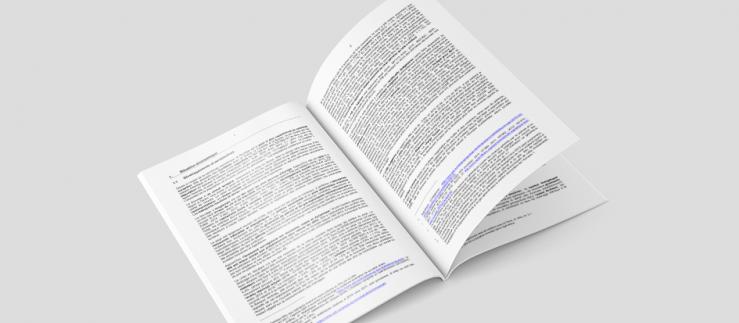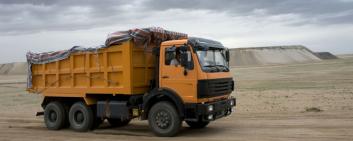Since the collapse of the Soviet Union, the quality of life in Kazakhstan has been driven by one thing: oil. In less than 20 years, Kazakhstan’s gross domestic product has increased significantly. Since 2006, it has ranked alongside countries with the highest average income, such as Mexico and Algeria. In 2015, the oil industry still accounted for 18% of GDP and 60% of exports.
The ninth largest country in the world by land area, Kazakhstan is, after Russia, by far the biggest state to emerge from the dissolution of the Soviet Union in 1991. Fewer than 17.5 million people live in an area similar to that of the European Union. Nearly 60% of its population lives in the big cities: Almaty, the old capital, Astana, the economic and demographic powerhouse of the country, Shymkent and Karaganda – all of which have more than half a million inhabitants.
Kazakhstan has massive reserves of oil and natural gas, including the giant Kashagan oilfield, in the North Caspian Sea, where Italy’s Eni is among those involved.
Kazakhstan also has huge mineral resources, which account for another 15% of exports, mainly to China. The country’s resources used to account for 90% of Soviet chrome and half of its lead, copper, and zinc. Uranium mining is also of considerable importance and the country is the leading exporter of coal, Kazakhstan’s main energy source. The country is also host to 20% of the former Soviet Union’s farming land. The north produces large quantities of wheat, while in the south the major crops are fruit, vegetables, tobacco, rice, hemp, and cotton.
The fall of oil prices in recent years has obviously had a severe impact on the economy of Kazakhstan. This has been compounded by the difficulties faced by its main trading partners, China and Russia. The growth rate in Kazakhstan slowed from 5.8% in 2013 to 1.2% in 2015. Now the World Bank estimates that it will fluctuate between -0.5% and 0.1% in 2016. In addition, Kazakhstan’s Tenge plunged to an all-time low last year, resulting in an increase in the price of Swiss imported goods.
“However, exporters on the lookout for attractive target markets should not be deceived by macroeconomic first impressions,” says Monica Zurfluh, Head of Southern Switzerland at Switzerland Global Enterprise. “Indeed, Swiss companies have been presented with numerous glimmers of hope and real opportunities to do business in Kazakhstan.”
Politically and economically speaking, Kazakhstan is one of the most developed countries in the region and welcomes foreign investors.
As a member of the Eurasian Customs Union. An association formed by a number of countries who agree not to levy customs duties when goods are exchanged between members and to apply a common external tariff to goods from non-member countries. The European Union (EU) is an example of a customs union. Details of its customs rates are provided in TARIC (Tarif Intégré de la Communauté) and are available on the Internet. Switzerland and Liechtenstein also form a customs union, whereas the free trade zone EFTA is not a customs union., together with Russia and other countries of the Commonwealth of Independent States, Kazakhstan is offered access to a huge internal market. Strictly speaking, this term refers to the totality of all the markets within a national economy where goods and services are traded or provided for internal use. The rules applying to the Swiss internal market are laid down by the federal law on the internal market (BGBM, SR 943.02) of 6th October 1995.
In the broader sense of the term, however, an internal market does not have to be restricted to one country’s national economy. An example is the single European market, which covers the 27 Member States of the European Union (EU). This EU-wide internal market constitutes an area without internal borders where the free movement of goods, services, persons and capital is guaranteed. One of the aims is to make it impossible for individual Member States to increase the price of imported goods by adopting a protectionist foreign trade policy (e.g. custom duties or technical barriers to trade) with a view to protecting their own national economy and products. Decisive steps on the road towards the single European market were the publication of a European Commission legislative programme in a 1985 White Paper and the Single European Act of 1986 which complemented and expanded the treaties on which the EU was founded.
The treaty on the European Economic Area (EEA) extended the single market legislation of the 19 EU countries to the EFTA states of Liechtenstein, Norway and Iceland. Switzerland, also a member of the European Free Trade Association (EFTA), rejected entry to the EEA in a 1992 referendum.. As a matter of fact, many foreign companies have chosen this country as a hub for the entire region.
Its debt load is minimal and a substantial sovereign wealth fund was set up with its oil profits over the past few decades.
Today, these resources are driving the process of transformation of the economy, known as the ‘Nurly Zhol’ program. The State has invested 9 billion US dollars and the same amount will come from other organizations.
“Substantial support has been dedicated to transport infrastructure, industrialization, and the promotion of know-how,” adds Zurfluh. “The government has recognized the importance of diversifying the country’s economy so that it does not depend on oil. Technologies and local manufacturing are promoted in order to reduce imports. At the same time, though, it is necessary to modernize existing infrastructure.” We can see a snapshot of Kazakhstan’s potential in its capital city, Astana - literally meaning ‘capital’ in Kazakh - whose name has changed three times since its foundation in 1824. It was here that President Nursultan Nazarbayev decided to transfer the capital in 1998, moving it to a much more central location than Almaty. The number of Kazakhs has increased from around half to nearly two-thirds of the total population since 1989, and 70% of Kazakhs are Sunni Muslims. In just a few years, a metropolis complete with modern infrastructure has essentially sprung from the desert, offering inhabitants a high quality of life despite the continental climate.
“Another priority for the government is the privatization of State-owned companies,” Zurfluh notes. Since January 2016 there has been a list of corporations that are due to be sold by 2020. These include the state oil and gas company KazMunayGas, the country’s railways, postal service, flag-carrying airlines, national energy company, and many more. As a result, the state’s share of the economy will fall from 50% to 15%, while the sale of these companies should generate substantial revenue for state coffers.
Last but not least, Kazakhstan takes advantage of its strategic location in Central Asia. China has announced its ‘New Silk Road’ initiative: an infrastructure network extending all the way to Europe and crossing Kazakhstan, where China intends to invest heavily. In March 2015, the two countries signed a ‘Memorandum of Understanding’, as well as other 33 agreements are becoming increasingly important within the context of international commerce. Given the different written laws and forms of legal practice that exist across the world and the different interpretations of the law that are culturally conditioned, it is impossible to devote too much attention to devising “good” agreements. Model agreements have proven to be useful, particularly for companies with little experience in this area. to cooperate on production in the steel, flat glass, oil refining, hydropower, and automobile sectors, worth a total of 23.6 billion US dollars. Kazakhstan itself has committed to investing 3 billion US dollars in infrastructure projects by 2018, including high-speed rail lines connecting China and Russia.
“For sectors directly or indirectly involved in infrastructure construction there are a variety of opportunities coming into play,” Zurfluh adds. The World Expo is focusing on growth, especially in the construction sector, which reached 4.3% in 2015. Efforts to expand and modernize existing industries have positive knock-on effects especially for experts in the extraction of metal ores, metallurgy, chemicals, and petrochemicals, while investors can hope for support from the government.
“This is true in particular for the chemicals sector, where a number of big projects are nearing completion or being planned. These include refineries, a fertilizer plant, and a polyethylene and propylene chemicals complex that are set to receive investments of up to 8 billion US dollars,” Zurfluh says. Today Kazakhstan imports 90% of its machinery, even if demand has fallen in the wake of the global crisis.
“Obviously, both the food and food technology sectors benefits from the country’s willingness to reduce imports. We believe that all sectors linked to sustainable and green technology represent an outstanding opportunity,” says Zurfluh. “After all, the theme of the Expo, to be held in Astana in 2017, is a priority for the Government of Kazakhstan that intends to create a more sustainable energy supply system.” Although some may smirk, according to Zurfluh “there are ambitious plans to make the country’s economy more energy efficient, backed up by a ‘Green Economy’ strategy in place since 2013.”
Why? It is actually very simple. “Industrial sector energy consumption over GDP is very high: about four times higher than industrialized countries. This is caused by old and obsolete machinery, plants, and infrastructures. And it’s in these sectors that Swiss Cleantech companies - renowned for their quality, innovative approach, and sustainability - can establish themselves,” Zurfluh adds.
“If on one hand the country offers progressive ideas and opportunities, on the other hand there are still a number of obstacles that make entering the market difficult for Swiss exporters. Even though the government is moving ahead with reforms, excessive red tape and corruption acts as a brake on free competition in many countries. As such, any assessment of a foreign market should also cover the risks presented by corruption. The non-governmental organisation Transparency International regularly publishes a Corruption Perceptions Index with details of around 90 countries.
The index helps the reader evaluate the relative level of corruption risk in their target market. Drawing on information from 16 investigations by eight independent organisations, the index is able to paint a very accurate picture. In 1999, Transparency International published an additional index which classified export countries according to their tendency to offer bribes (Bribe Payers Index). On request, the official agencies of the Swiss government in the various target markets can also provide a verbal assessment of the political and other types of risk in the respective countries. still pose a real challenge, as is often the case in many emerging countries.”
And the problems don’t stop with bureaucracy. Like any emerging country, it is necessary to bridge infrastructure gaps that still exist despite massive public investment. “The poor state of the country’s infrastructure makes logistics problematic. More generally, cultural and linguistic differences are another hurdle that has to be overcome. The severe fall in the currency in the second half of 2015 is not good news for Swiss businesses, which in any case have to struggle with the strong Swiss franc,” stresses Zurfluh. Even so, with good preparation and help on the ground, it is possible to get past all these barriers. “Our organization offers a global network of Trade Points, supporting Swiss exporters. It is particularly present in Astana, in the Swiss embassy, which has developed specific knowledge of the Kazakh market and the network of contacts that are necessary, even essential, for doing business,” Zurfluh says. “In particular, we advise seasoned exporters to consider Kazakhstan as a target market. First, it’s important to analyze your own industry in depth, the demand and local competitors, as well as decision makers within companies and authorities.
“The key to achieving this goal is having a trusted partner with a network of contacts on the ground. Personal, reliable relationships are crucial in building long-lasting and effective business partnerships. Managers will also need to travel frequently to Kazakhstan,” Zurfluh says. Lastly, the Switzerland Global Enterprise manager adds: “To enter a market successfully you need to work out the timing and make careful plans for customs duties are a form of tax payable to the State mainly when importing goods into a customs territory. From a protectionist perspective, protective duties play an important role as they are designed to afford domestic producers some protection against foreign competition. In most countries, customs duties are levied as an ad valorem duty, which means the level of duty payable is calculated as a percentage of the value of a given product. By contrast, Switzerland applies the “specific tariff” system for most goods. The specific tariff here is payable per 100 kg net weight. Given the numerous customs duty reductions under the General Agreement on Tariffs and Trade (GATT; now the World Trade Organization), customs are now much less important in terms of international trade. In Switzerland, the Swiss Federal Customs Administration (FCA) is responsible for levying customs duties. Internationally, customs administration authorities are members of the broader World Customs Organization (WCOOMD). and logistics, as well as obtain the necessary permits.”
The Astana Expo
From June 10 to September 10, 2017, some seven million people are expected to visit Astana for the first Expo ever to be held in a Central Asian country. The theme of Expo 2017 in Astana is “Future Energy” focusing on responsible and efficient energy generation in the respect of the environment, with special attention on renewable energies. With over a hundred countries officially participating, the event will set out to link together the Milan 2015 Expo, whose theme was ‘Feed the Planet’, and Dubai 2020, whose theme will be ‘Connecting minds, creating the future’.
This article was first published in Ticino Management in December 2016.







